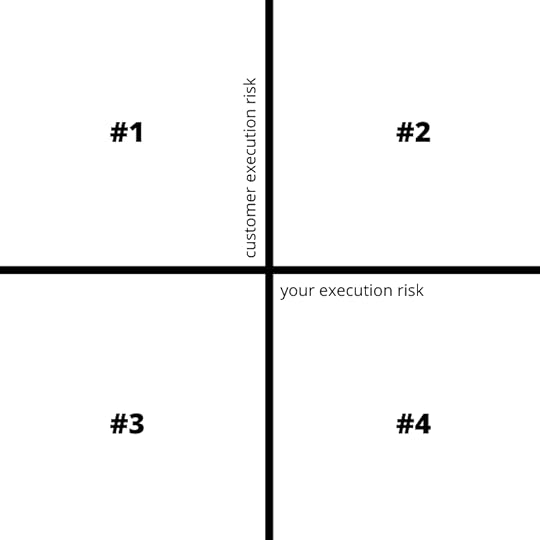New Customer Relationship Management

Start Small
Always start a new customer relationship with the smallest project possible.
Here is a cautionary tale.
A former client firm of mine, which I’ll call Ajaz Systems, had uncovered the single largest sales opportunity in their history.
They usually sold products in the price range of $20,000 per unit. One day a prospect announced that they needed ten units to support a new internal initiative. This potential sale represented a great growth opportunity for Ajaz.
Their competition was a big company, many times the size of Ajaz. Although Ajaz’s solution was technically superior to the competitor’s, the competitor was playing the big-company game.
Just as IBM frequently was accused of doing back when they were the biggest game in town, the competitor was trying to spread fear, uncertainty, and doubt about Ajaz and their ability to support their products and the customer in the long term.
The competition was telling the customer that Ajaz didn’t have the resources to support such a large order, that a small company couldn’t support a roll-out of ten units to five different locations across the country. The competition reminded the customer that they were a large enterprise operating on five continents and could knock out an order like this with their eyes closed.
In one regard they were right. Ajaz had never before won a single order this large. It would be a challenge to Ajaz to manage the project, and the CEO was nervous about the potential liability and the damage to their reputation if they failed.
The
competition had maneuvered Ajaz into a classic catch-22 for small companies
trying to compete with the elephants. How were they going to build the
capability to support larger customers with large orders if they were never
given the opportunity to try?
“Yes, it seems to me that Ajaz
was right to be nervous. Sometimes there are deals that you just shouldn’t
compete for.”
What would you have done in this situation, MILT.
[NOTE: For new readers, “MILT” is an avatar for a CEO or VP sales at a small to mid-sized company.]
“I probably would have passed
on the opportunity.”
Why?
“It’s important to recognize
your limitations. You preach the importance of not wasting time. Competing for
a deal that one has extremely low odds of winning is a waste of time.”
Well,
that’s one way to look at it. But here’s another way: You can change the rules
of the game to turn your weaknesses into strengths that enable you to compete.
My recommendation to the CEO of Ajaz was to play to Ajaz’s strengths rather than to those of the competition. Instead of trying to convince the customer that they could handle such a big task, Ajaz’s job was to turn the sales competition into a contest over just the first unit the customer would buy.
Ajaz knew they could prove to the customer that they had the better technical solution. And they had great customer references. If they could persuade the customer to buy just a single initial unit, to be followed by additional single-unit orders over time, then Ajaz would dramatically increase their odds of winning all the business.
It worked. They sold the customer on the idea of starting the project with just a single system installation, instead of ten. The Actual Decision-Maker (ADM), who had the responsibility to manage the roll-out and integrate these systems internally, jumped at the opportunity. He saw that there was no downside for him because he was mitigating his risk on three fronts: the initial investment, Ajaz’s performance, and his internal implementation resources.
If the initial system didn’t work up to spec, then the ADM could change vendors with minimal downside. If the customer was satisfied with the initial implementation, then they could order and roll out additional units as needed. Ajaz sweetened the pie by committing to honor the ten-unit pricing they had proposed and said the customer could cancel the first order at any time if they felt it wasn’t meeting their needs. Sell Low, Start Small, Practice Unconditional Support.
“How did the competition
respond?”
They
weren’t happy. When the prospect told them he was changing the scope of the
initial acquisition, they lost most of their interest in the deal. They were
expecting a large order commensurate with their company’s size. When that
changed it took the wind out of their sails. Most important, it made the
procurement about the products again and not about large-project management.
Their competitive advantage disappeared.
Corollary #1: Start small to reduce customer risk

Customers will often welcome your suggestion to reduce the size of an order—especially if you haven’t previously done business with them.
In every transaction between new business partners there are unknowns and concerns and a desire on both sides to minimize the risks. Starting a business relationship with a small order is the best way for the buyer and seller to become familiar with each other. It is the easiest way for the buyer to build trust and confidence in the seller’s ability to live up to their promise to deliver a product that works as advertised.
Deciding
to take a small bite is easier for the customer because it costs less than a
big bite. Companies typically prefer to manage their risks by making a series
of smaller changes in place of one big change.
As the seller, you get your foot in the door and give your company a chance to prove that it’s just as capable as a larger company. Who cares if the initial order is only for one unit?
Once you get one, you’ll get them all—and not just the initial ten systems, but all the orders after that, too. You’ll be locked in as the vendor of choice. As long as you continue to provide unconditional support, the buyer will keep returning to you for future orders. By going small, you get rid of the competition—not just in the beginning, but forever.
Corollary #2: Start small to reduce your risk

Risk is not one-sided. Neither are trust and confidence. There are tales too numerous to count about small enterprises that won the big order from their dream customer and ended up being mortally wounded by it.
How many times has an SMB won a big order from a big company, bought inventory and hired people to support it, and then had the customer freeze all purchases for three to six months because it had a downturn in sales? The SMB is stuck with inventory and employees it doesn’t need and begins to suffer under the weight of this unanticipated financial burden.
A
key reason to start with small bites is to lower your risk in the transaction.
Rather than depend on the customer to live up to their end of a deal, make it
easier for them by starting small and growing incrementally.
“Are you saying that I shouldn’t
take an order for 20 units if I can get an order for two units?”
Not
at all. What I am saying is that if the customer says they need 20 units over
six months, then sell them on the benefits of buying two units now, installing
and integrating them as required, and proving that your product works and
delivers the benefits as promised. Then take an order for the next two, and so
on. Match the order to the customer’s actual requirements.
Rightsizing
your orders, or taking smaller orders, also reduces your sales risk. The bigger
the order you are trying to win, the higher within a customer organization
you’ll have to sell. The smaller the project, the easier it will be to keep the
decision with the Actual Decision-Maker (who can claim internally that he saved
the company money and reduced risk).
Corollary #3: Start small to level the playing field

If you are in a tight competitive situation, reducing the size of the prize is the best way to level the playing field.
Big
companies are reluctant to change course in the middle of a sales cycle. If you
are able to convince the customer of the benefits of starting small, your
competition will take this as a sign that the prospect is backing away from
their urgency to buy something. If the size of a potential order suddenly
becomes much smaller, the bigger competitors will lose interest and leave a
more open field for you.
The
key for you, as the smaller business, is to stay the course. One risk to you in
this approach is that the customer will rethink their entire requirement. Stay
engaged with the customer with high-value responsive communications that give
them solid financial and product reasons to buy your product.
Look
at this from the perspective of the customer. By rightsizing the order, you
just made it easier for the customer to make a decision. Starting small isn’t
reducing the size of the project. It’s reducing the risk. You have made the
decision easier for the customer as well.
Immediate Need vs. Ultimate Requirement
Buyers often frame their needs in terms of their ultimate requirements. For example, let’s say a company called Kaliphan, Inc. contacts your firm and a big competitor about their product requirements: “We are going to roll out ten new offices this year; therefore we need ten new systems.” Like customers everywhere, Kaliphan wants sellers’ undivided attention as well as the best possible price, so they combine their requirements into one procurement. But that isn’t all that they want.
Kaliphan
also wants to protect their downside risk. They want to succeed, but more than
that, the people making the purchase decision don’t want to fail. They’ll
purchase all ten systems at once if they have to, but they would prefer to
procure the ten systems on a schedule that matches their roll-out or usage
requirements.
As
a Zero-Time seller, you are going to give Kaliphan the same support and service
whether they buy one system or a hundred. But as a smaller business you would
prefer that they buy just one. And that works to your advantage. Kaliphan knows
that you can support one system but might be uneasy about whether you could
support ten at one time. Ironically, the customer will have very little
objection to buying ten systems from you if they can do it one or two systems
at a time. At the end of the day you’ve sold and are supporting ten systems,
but you’ve done so using a method that plays to your strengths.
You
never have to prove to the customer that you can support ten systems at once.
You just have to prove that you can support one system and then do it ten times
in succession.
If
you allow a bigger competitor to define a sales competition, they will cast it
as a contest between the two of you to support the simultaneous implementation
of ten systems. You wouldn’t be favored to win that battle, and you’re likely
to lose it. The competitor’s sales team will be licking their chops and
spending their commission checks in anticipation of winning the battle.
So,
you talk with the Actual Decision-Maker at Kaliphan about the advantages of
starting small, reducing implementation complexity, reducing risk, and
increasing the chances of success: “Let’s make sure the system is integrated
smoothly at one location before going to other locations.” “Let’s make sure we
understand how to integrate and develop a process that can be used at all the
other locations.” With these ideas you are creating value in the eyes of the
buyer, increasing the chances of success. Which will make him/her look better.
“What happened with Ajaz?”
They
got the first order and made sure the first installation was successful by
supporting the customer like there was no tomorrow. And then they took the
orders for the nine additional systems. One at a time.
Key Takeaways
In new customer relationships, reduce the customer’s risk, and yours, by starting small.Increase your competitive advantage by right-sizing the order.Reduce your implementation risk by starting small.
How To Reduce Risk
To increase your odds of sales success you need to reduce the risks of failure, for both yourself and the buyer.
If you can reduce the customer’s risk in buying from you, you’ll reduce your risk of losing the order. Reducing the customer risk increases the odds of a deal happening.
“Whoa, hang on there for a second.”
What can I do for you, Milt?
“I’m not sure I understand what you mean by reducing the risk of failure.”
Fair enough.
First, let’s look at risk from the perspective of the
customer. When a customer purchases a product or service from you they are
assuming several risks: Will your product work as you advertised? Will you be
able provide the level of support the customer needs to fully utilize your
product? Will your company be around to support the customer in the long run?
Will your product be reliable? What happens to the buyer, and their career and
credibility within their own organization, if they choose the wrong vendor or
product?
Second, evaluate risk from the perspective of you, the
seller. When you sell a product to a buyer, you risk being unable to deliver
the product on time and in the quantity the buyer demands. What if the customer
asks you to sell a quantity of product that will stretch your resources to
support? In that case you are taking a risk that you will fail to satisfy the
requirements of the buyer. You risk losing their business, but also run the
risk that your competitors will use your failure as a competitive wedge in
future deals.
Evaluate every potential sale you are working on in this light:
Where are the risks for the buyer if they buy from us?How do we contribute to those?What are the risks to us if we win?How can we win and reduce the risks for the customer and for us?
“How do we go about reducing risk?”
The easiest way to reduce the risk to your customer is
to decrease the size and scope of the opportunity you are working on.
“Why would I want to take a smaller order from the customer?”
If you succeed with the initial order you’ll increase your odds of getting get future orders from the customer.
Creating A Risk Profile

I have an easy method to evaluate your prospects in
order to strategize how to reduce risk to increase your chances of winning
their business.
I recommend that you create a risk profile for each
deal in your forecast.
Use a scale like the one in the Risk Assessment Quad below. In the RAQ the x-axis represents your execution risk if you win the deal. The y-axis represents the customer’s execution risk in giving you the order.
Let’s look at what types of deals we could find in
each quadrant.
Quadrant 1:
The customer wants a large quantity of your product to be delivered quickly. It would be a stretch for you to achieve this. You determine that the customer has the resources to deploy the product in the time frames they specify.
Quadrant 2:
The customer wants you to develop a customized version of your product to be delivered on an aggressive schedule. It would be a stretch for you to achieve this. And the customer needs you to deliver on schedule or they’ll miss their deadline with their customer.
Quadrant 3:
The customer has asked for bids for a small quantity of products to be installed in one location. The delivery requirements fall within your normal timeframes and the customer has the resources to deploy your products in the timeframe specified. Any support resources required will fall well within the support you normally provide to customers.
Quadrant 4:
The customer needs your product to integrate into a system they are delivering to their biggest customer. The required delivery schedule is not a problem for you. But if you don’t deliver on time your customer will miss their deadlines with their customer and be subject to financial penalties.
To start, map your entire current pipeline on an RAQ.
“What do I do with this information?”
Once a week, plot your deals on the Quad. Strategize a way to move as many of your forecast orders to the lower left quadrant (#3) as possible.
Your Action Items
Plot your entire current pipeline on the Risk Assessment Quadrant.Strategize how to reduce the scope of prospect orders in Quadrants 2 and 4.Repeat each week in sales meetings or one-on-one pipeline reviews.
The post New Customer Relationship Management appeared first on Andy Paul.
Andy Paul's Blog
- Andy Paul's profile
- 4 followers



